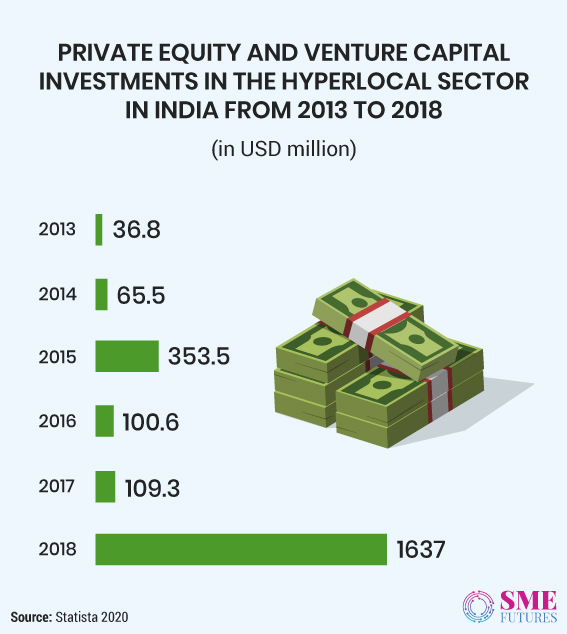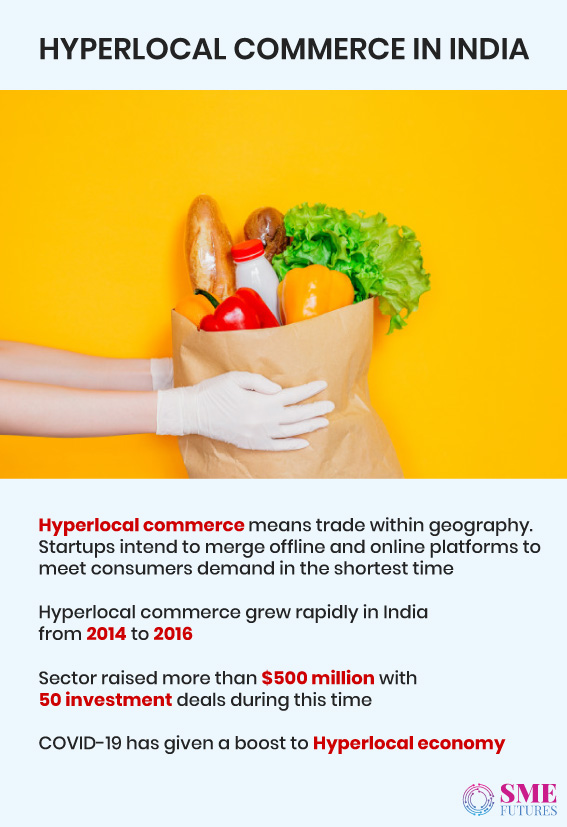The pandemic has entirely changed the markets and the way India Inc operated their businesses. In just few months, entire retail paradigm has shifted from mega malls and e-commerce to hyperlocal economical units. As the economy plunged during the lockdown, businesses started relying on locally available produce or resources to replenish demand.
As a result, everyone from consumers to companies are keen to adopt hyperlocal channels for survival. One such example is of Zomato and Swiggy which forayed into grocery delivery to meet consumers’ demands in collaboration with neighbourhood Kirana stores.
What is hyperlocal economy?
One simple definition of hyperlocal economy is a business and its operations restricted to the same locality. All mom and pop stores, local haat, vegetable markets are good examples of a hyperlocal economy. However, the new definition of it encompasses more added features to it. The retail and distribution is now administrated through GPS locations and mobile apps.
The term was first coined in 1991 but it was Mahatma Gandhi who argued for local production and consumption in Indian economy. The Made in India drive was then confined to freedom struggle. However, it appears that businesses now wish to stick to fundamentals during these unprecedented times.
The last time hyperlocal sector in India saw rise was when the players such as Domino’s and Pizza Hut began food deliveries. Then, other food joints also started home deliveries. The period from 2014 to 2016 can be called as the pinnacle of hyperlocal culture in India when new players like Zomato, Swiggy, Foodpanda took over reigns. According to some media reports, the sector raised more than 50 investment deals with over $500 million during this time.
The hyperlocal market in India is currently driven by logistics, food, groceries, pharmacy, horizontal, and concierge. Companies like Grofers, Urban Company, Dunzo, Zopper, Big Basket, Shadowfax, Milkbasket etc also joined the bandwagon and are doing great in it. In 2017-18, the market saw an investment of $2 billion while it clocked $1 billion towards the end of 2019.

Proliferation of hyperlocal startups in COVID-19 times
Consumers’ behaviour has immensely changed due to the wrath of pandemic. They now want everything with ease and within vicinity without venturing out much. Indian consumers always preferred to shop at their pet local stores due to multiple factors. Reasons for this are primarily related to trust built in years and the comfort of stores being in the neighbourhood.
Hyperlocal model hence became most relevant in the current pandemic scenario because these were able to cater all kinds of needs. This in turn accelerated growth of the hyperlocal e-commerce sector with an increasing number of consumers both in metro and non-metro cities. Out of this, most of the consumers transacted on online or hyperlocal app platforms in India.
As a user of hyperlocal platforms and as an entrepreneur, Siddharth Marupeddi, CEO at ULearn feels that though economy is depicting a downward curve, ease of doing business has enhanced potential of such platforms.
He tells, “With NBFCs infusing huge capital into the market as short loans (unsecured and commodity loans), the setup costs to start an MSME is comparatively quite less today. If we look at lending apps’ online ad with the mushroom growth of credit card usage for shopping, we will witness that an immense growth of Indian e-commerce in next five years is inevitable.”
The popularity of hyperlocal platforms was evident in rise of the online orders of Grofers. It saw a 45 per cent rise in orders along with 18 per cent hike in order value with the onset of lockdown. Big Basket and Amazon Fresh also registered similar hikes. Seeing the opportunity, Walmart owned Flipkart started its own hyperlocal delivery service called Flipkart Quick.
Earlier, Paytm Mall had also announced to partner with 10,000 local retailers for hyperlocal services. Swiggy in the similar vein, opened its Instamart for consumers in August with 2,500 items in the cart.
“Through Instamart, we want to introduce the convenience grocery category in India. With the fastest deliveries in the segment (30-45 minutes), day and night serviceability (7 am – 12 midnight), and a wide assortment across various categories, Instamart will address the unmet grocery needs of the time-pressed, convenience-seeking urban consumer,” Swiggy said in a statement.
Another such example is Almond House of Hyderabad, a sweet and savoury retail brand which realised the significance of hyperlocal services to stay relevant in the grim situation for businesses. Chaitanya Muppala, CEO, Almond House confesses that going hyperlocal was a right step to generate revenue.
Similarly, Ease Your Life (EYL), a hyperlocal delivery service is registering remarkable number of orders on the daily basis. According to their founders, Shashwat Bhatt and Jaymin Trivedi, EYL’s base point pricing systems for deliveries and the list of vendors has seen a nearly 25 per cent growth.
Shashwat Bhatt says, “The new normal has given rise and opportunity to multiple small businesses and entrepreneurs or homepreneurs. The impact can be witnessed on everyone from bakers to home chefs to cloud kitchens. It has also spilled to small designers and home boutiques. This new local retail sector is now going to be the backbone and livelihood for millions.”
He further adds that hyperlocal commerce model is not in vogue only in metro cities, but it is also becoming popular in tier 3 and 4 cities also. Bhatt then asserts, “Ease of life and convenience is sought after by any consumer be it from a tier 1 or a tier 4 city. We recently started pilot operations in Gwalior and responses were promising.”
Another Hyperlocal startup DealShare, has been experienced a significant growth in daily transactions. Founded in 2018 by Vineet Rao, Sourjyendu Medda, Sankar Bora and Rajat Shikhar, this social e-commerce firm offers relevant catalogue of products with low prices. The company supports local manufacturers, small businesses, and merchants by featuring their products with customer-to-manufacturer (C2M) model.
Sourjyendu Medda, Founder, Chief Business Officer and Chief Finance Officer informs, “When local SMEs were not able to get their facilities running and were seeking support in terms of transportation and logistics, DealShare came ahead and helped many of them. We helped in opening their facilities by getting them special permissions because they were delivering and producing essential goods.”
DealShare ended up delivering more than 25,000 orders across various pin codes each day during the lockdown. He also tells that as an effort to give back to society, DealShare also provided essential groceries free of cost to underprivileged households affected by the pandemic.
Medda further emphasizing on USPs of the platform informs us that their target customers are usually from middle class or below, who have never interacted with any e-commerce companies. He then elaborates, “Our app therefore is in vernacular language. With its user-friendly experience, it gives DealShare a unique space in minds of customers.”
At the supplier’s side, they have given local regional brands a national platform in grocery space to promote their products. This is a win-win situation for all their customers and them as consumers get good quality products for much cheaper prices.
They have also introduced an innovative programme called DealShare Dost (DSD) which is creating micro-entrepreneurs across various cities and clusters, wherever they operate from. This makes logistics cheap and thereby a business profitable with excellent service to consumers.
Meanwhile, not only hyperlocal grocery delivery businesses but also other startups with various services are gaining significance during these times. The prominent name that pops up in mind is Urban Company (previously Urban Clap), a platform that provides myriad services across categories such as beauty and wellness, hospitality, home repairs and maintenance.
According to the company, there was a significance growth in the business during pandemic. Since the lockdown ended, the company has bounced back stronger and seen 2.5 times jump over pre-COVID time. A huge part of this demand has come from first time users attributing to about 80 per cent growth.
The company has been on-boarding more than 1000 service professionals every month since June to meet the rising consumer demand. Further, they have shipped more than 2 million PPE kits (comprising gloves, masks, sanitisers and face shields) for service professionals since April 2020. It therefore remains committed towards the safety of its employees.
To meet the demand of July, they launched haircut and grooming services for men and kids in five more cities. In a recent freedom sale, the platform saw a 300 per cent increase in traffic through the app. It hence clocked 200 per cent jump in sales on the first day as compared to the opening day of last year’s freedom sale.
Further, the number of transactions from tier-II cities grew by 1.5 times in the first week of the when compared to sales of May-June 2020. Compared with May-June 2020 levels, all major categories such as salon for women, men’s haircut and grooming, cleaning and massage services etc also saw a spike in deliveries which led to an increased contribution to overall business.
Another startup in the series is Bengaluru based Iamhere, a hyperlocal social network to discover, connect, and engage in the neighbourhood. It is primarily to nurture one’s hobby, interests, or profession. Owing to the pandemic, the platform has also witnessed a rise in number of users and engagement.
Talking to us about the rise in popularity of hyperlocal business model during the pandemic, Founder and CEO, Naren Kumar tells that they now have 200 thousand users across India. He elaborates, “Today neighbourhood services are the best alternative. Since February, we have seen a spike in number of users. There is almost 40 per cent rise in hyperlocal marketplace interactions which covers farm produce, doorstep services, trainers and small businesses.”
He further says that the hyperlocal business model has been gaining attention since 2015. This was the time when delivery businesses whether in grocery, food, services, pure deliveries came into existence. But, things have changed a lot after that, however as there was a gap for social connecting platform among the pool of hyperlocal vertical players, we came into existence.
“Through social media apps such as Facebook, we can now connect to people globally. But, finding and connecting people in the neighbourhood is still difficult. With IamHere we are filling that gap by providing location as a platform to connect people within neighbourhood. It is hence helpful in developing communities for hobbies, business or social causes,” Kumar adds.
In another recent development, ShareChat which is a video creation app like Tiktok has acquired Circle Internet. The latter is a hyperlocal information platform for first-language Indian internet users.
Commenting on the acquisition, Manohar Charan, VP – Corporate Development and Strategic Finance, ShareChat proclaims, “The acquisition will help us penetrating deeper into geographies and nurture a thriving hyperlocal content ecosystem. This will further help us in understanding and serving the latent content needs of next billion internet users more effectively.”

Challenges in hyperlocalising businesses
Despite numerous positive factors surrounding the hyperlocal space, the industry creates a fair bit of challenges as well. The hyperlocal model hence may appear simple enough in theory but is lot more difficult when it comes to implementation. One of the biggest challenges that a hyperlocal business may face is to keep track of the inventory with local merchants.
This would require a dedicated and an open two-way communication between the merchant and the marketplace. Effective and adequate training is another challenge which hyperlocal businesses may face. Training to local delivery boys, mechanics, or service providers is a critical aspect as they act as the face of a company.
Having experienced some of the challenges in the space, Bhatt of Ease Your Life says that there are many challenges while dealing with the hyperlocal format. This is because we are committed on delivering the promise of easing people’s lives for our customers. Hence, we are dependent on the delivery person who will help us in fulfilling this promise.
He confesses, “We constantly have to ensure that we are delighting customers through our services. It is often noticed that dissatisfied customers to switch to other vendors. At the same time, keeping our delivery boys together and constantly motivating them to deliver 100 per cent on their task is also a constant challenge.”
Kumar of Iamhere highlights another set of challenges. One of the primary challenges is privacy and security of the users while conducting transactions in the hyperlocal environment. According to him, privacy and security is a big constraint for hyperlocal social connect apps such as his.
He adds, “It was one of the biggest issues that we had faced. Users connecting to others on our app whether socialising or doing commerce have to share private information. They often don’t want to do that. We hence ensured to provide them a safe private anonymous infrastructure with tech solutions around security.”
Next formidable challenge is of doing transactions. Naren tells that most of the e-commerce companies allow transactions within their platforms. However, it is not always the case in a hyperlocal business. One can go directly to the local retailer and pay them even if he or she has ordered online.
“Just like FB one can place an order on the hyperlocal platform and transact through outside channel. We also have to adopt the same model such as this by making revenue through the ads,” Kumar informs.
The retail industry is more than a trillion-dollar economy in India. While there is a huge shift in retail trends, competition between the players is also on surge. However, the hyper-local economy requires a unique culture for a company to survive. Thus, competition in the space can be a challenge for many players.
Medda advices, “Every locality is different in India. A business despite of being big can survive in the hyper-local scenario only if it has the hyper-local intelligence of customer behaviour and product or brand preferences. Ability to build strong relations with every customer in the way they prefer is the most challenging aspect in a hyperlocal economy.”
Future of hyperlocal enterprises in post-COVID era
The pandemic has accelerated growth of hyperlocal e-commerce sector with an increasing number of consumers both in metropolitan cities and small towns. Earlier, Ken Research estimated in a report India Hyperlocal Market Outlook to 2020 that Indian hyperlocal market will grow at a considerable CAGR rate, thus exceeding Rs 2,306 crore by 2020.
India and many nations across the world saw online outlets as the fastest-growing grocery retail sales channel in over the past six months. Along with this, the first-time e-commerce users also increased during the lockdown. The onset of pandemic also brought out several consumer behaviour changes such as contactless delivery and digital payments.
Medda says, “During lockdown across India since March, several enterprises saw an accelerated conversion. Therefore, maintaining optimal price, shopper convenience, and experience will dictate the change in the continued user adoption. It is very evident that hyperlocal economy players offer a suite of convenience and value benefits.”
Factors that have worked in favour of a hyperlocal ecosystem are that this platform is a very quick, flexible, and an asset light model. These start-ups usually act as aggregators to connect the local businesses with nearby buyers. The cost of infrastructure is also low as compared to e-commerce firms. With this dynamic combination of online channels connecting the offline vendors to consumers, the hyperlocal model is offering the best of both worlds to consumers.

The immense scope in this industry has hence attracted continuous interest from investors from around the world. Bhatt opines,
“In my opinion, India as a market is very well prepared to welcome this wave of positive developments in hyper-local market and even more so in the post COVID era. People today are hassled with multiple things to keep themselves healthy, but a hyperlocal service is always there to cater to their needs.”
Talking about the future roadmap of EYL, Bhatt says that one of their biggest Initiatives is the e-commerce integration within their website and apps. This is how, EYL will soon be a marketplace for all partners and business which will thrive and grow together.
“While EYL will look at end-to-end marketing support and logistics, partners will now be able to have complete inventory management at their fingertips. They will also be able to promote goods and services which can cater best to the audiences they serve. This will indeed prove to be a game changer,” concludes Bhatt.











